Long COVID Self-Management - Oxygen
Oxygen is a gas that is found in the air. This gas is important for many bodily functions. When you breathe in, oxygen enters the lungs and is exchanged for carbon dioxide (CO2) when you breathe out. The level of carbon dioxide in your body is what causes the breathing response. This is the reason why people with low levels of oxygen may or may not experience the same amount of shortness of breath.
When your body’s oxygen levels are low, your heart works harder. You may feel tired, short of breath, confused, or forgetful. Oxygen therapy helps people with low levels of oxygen in their blood.
Certain tests can help a doctor determine if extra oxygen is needed. If a doctor recommends oxygen therapy, a person will need to be seen regularly by the doctor for check-ups. For some people, oxygen therapy can be temporary. For others, it can be permanent. Other people may only need it when they exercise. It is important for you to use your oxygen according to your doctor’s recommendation.
What is Oxygen?
Oxygen is a gas that is found in the air and is necessary for your body to perform multiple functions.
- There is 21 per cent oxygen in the air we breathe.
- Oxygen has no colour, smell or taste.
- Oxygen cannot be lit but will speed up making flames bigger.
- Oxygen is considered a medicine. It requires a doctor’s prescription and must be adjusted to your needs.
How is it measured?
Oxygen is measured using a pulse oximeter or a test called arterial blood gas.
Pulse Oximetry
- This is a simple and pain-free way to measure oxygen. A light sensor is placed on your finger or forehead.
- The accuracy of pulse oximetry can be affected if the patient has poor blood flow in their hands or an irregular heartbeat. Other factors such as nail polish on fingernails, movement or having cold hands can cause oxygen readings to be incorrect.
Arterial Blood Gas
- This is the most accurate way to measure oxygen levels in your blood.
- A blood sample is taken directly from an artery in your arm or wrist.
- You will need an arterial blood gas (or a six minute walking test) to qualify for long-term oxygen therapy funding from the government.
Oxygen Safety
- Always use your oxygen therapy as prescribed.
- Do not smoke near your oxygen tubing, cannula or system.
- Do not use your oxygen tubing or tank near an open flame (i.e., candle, gas stove, BBQ, fireplace)
- When cooking, avoid having your oxygen tube in contact with the heat by placing your oxygen tubing under an apron or have the tubing extend down your back.
- Do not use anything that could cause a spark near your oxygen tubing, cannula, or system (i.e., e-cigarettes, electric razors, hair dryers, etc.)
- Do not use petroleum-based creams or products when using oxygen. Instead, consider using water-based products.
- Do not use your oxygen system in a high humidity area, such as your bathroom, or in a sauna or indoor pool.
- When taking a shower, keep your oxygen system (i.e., concentrator) outside the bathroom and use a longer oxygen tubing. Showering requires a lot of energy, and you should be wearing your oxygen.
- Keep your oxygen equipment in a well-ventilated area to avoid a build-up of oxygen. Do not cover the oxygen equipment with clothing, curtains, or blankets as this is a safety hazard.
- Use the length of the oxygen tubing indicated for you.
- Keep your cylinders stored in a secure holder. Make sure that they are secured when travelling in a vehicle.
- If you are using a liquid oxygen device, be sure to detach the device from the reservoir before storing it.




